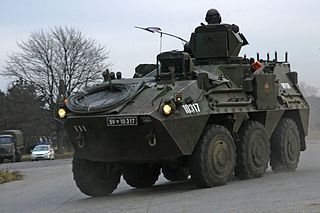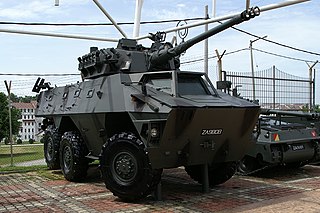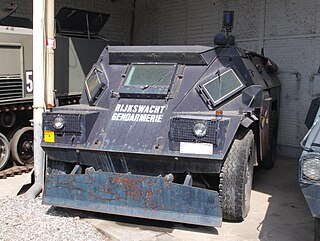
The Wiesel Armoured Weapons Carrier (AWC) is a German light air-transportable armoured fighting vehicle, more specifically a lightly armoured weapons carrier, produced by Rheinmetall. It is quite similar to historical scouting tankettes in size, form and function, and is the only true modern tankette in use in Western Europe.

The Panhard ERC is a French six-wheeled armoured car which is highly mobile and amphibious with an option of being NBC-proof. While various models were tested, only two versions of the ERC entered production in large numbers: the ERC-90 Lynx and the ERC-90 Sagaie. The main difference between the two versions is the type of turret and 90 mm gun fitted. Sagaie is French for assegai, a type of African spear.

The Bionix (BX) is a family of tracked Singaporean armoured fighting vehicles developed by ST Kinetics. Intended to augment the Singapore Army's aging M113 armoured personnel carriers, it is the first indigenous armoured vehicle to be developed in Southeast Asia. The Bionix has been operational with the Singapore Armed Forces (SAF) since 1999 in a wide variety of adaptations including the Bionix II, Bionix 25 and Bionix 40/50 variants.

The Cadillac Gage Commando, frequently denoted as the M706 in U.S. military service, is an American armored car designed to be amphibious. It was engineered by Cadillac Gage specifically for the United States Military Police Corps during the Vietnam War as an armed convoy escort vehicle. The Commando was one of the first vehicles to combine the traditionally separate roles of an armored personnel carrier and a conventional armored car, much like the Soviet BTR-40. Its notable height, amphibious capability, and waterproofed engine allowed American crews to fight effectively in the jungles of Vietnam by observing their opponents over thick vegetation and fording the country's deep rivers.

The K21 is a South Korean infantry fighting vehicle. A replacement for the K200-series, it was formerly designated as K300 or XK21 KNIFV. The initial production began in 2009, with the Republic of Korea Army planning to field approximately 466 units. It is designed to effectively defeat other IFVs as heavily armed and armored as the BMP-3.

The AIFV is a US tracked light armored vehicle that serves as an infantry fighting vehicle (IFV) in the armies of several countries. It is a development of the M113A1 armored personnel carrier.
A huge number of M113 Armored Personnel Carrier variants have been created, ranging from infantry carriers to nuclear missile carriers. The M113 armored personnel carrier has become one of the most prolific armored vehicles of the second half of the 20th century, and continues to serve with armies around the world in many roles.
The Henschel Wehrtechnik TH-200, TH-400, and TH-800 are a family of wheeled armoured fighting vehicles by Thyssen-Henschel. Their development was loosely related to the Spähpanzer Luchs.

The Simba is a wheeled armoured personnel carrier designed by GKN Sankey. and is currently in service with the Philippine Army.

The Dragoon 300 AFV was produced by Arrowpointe Corporation during the 1980s. It was based on the automotive components of the United States Army's M113 APCs and 5-ton trucks. It resembles a larger V-150 Commando.

Lahko kolesno oklepno vozilo Valuk is an improved version of Pandur 6X6 APC, manufactured under a license manufacturing agreement with the Austrian company, Steyr Daimler Puch Spezialfahrzeug AG & Co KG, by Sistemska Tehnika of Slovenia for the Slovenian Army.

The BTR-3 is an eight-wheel drive armored personnel carrier developed in 2000–2001 by an international consortium. The companies involved in the project include the Kharkiv Morozov Machine Building Design Bureau of Ukraine, Adcom Systems of Abu-Dhabi, UAE, and the State Scientific Technical Centre of Artillery & Rifle Arms of Ukraine. Although somewhat similar in appearance to the Soviet BTR-80, the BTR-3U is an all-new production vehicle rather than an update of the existing in-service vehicle.

The Anoa is a 6x6 armoured personnel carrier developed by PT Pindad of Indonesia. The vehicle is named after the Anoa, which is a type of buffalo indigenous to Indonesia. The prototype was first unveiled at the 61st anniversary of TNI on October 5, 2006, in TNI HQ at Cilangkap, east of capital Jakarta.

The Type 85 is a tracked armoured fighting vehicle produced by Chinese company Norinco. It is an improved version of the Type 63 armoured personnel carrier. The vehicle is bigger, has additional firing ports and periscopes, a longer chassis with an additional road wheel on each side, and is equipped with an NBC protection system.

Throughout its history, the Irish Army has used a number of armoured fighting vehicles.
FNSS Savunma Sistemleri A.Ş. is a Turkish defense manufacturer founded in 1988. It is owned 51% by Nurol Holding of Turkey and 49% by British–American firm BAE Systems Inc., and operates facilities located in Gölbaşı, Ankara.

Tulpar is a Turkish heavy infantry fighting vehicle designed by the Sakarya-based automotive manufacturer Otokar. It is named after the Tulpar, a winged horse in Turkic mythology.

The SIBMAS is a Belgian amphibious infantry fighting vehicle. It was engineered from the same prototype as the South African Ratel. In appearance the vehicle is also similar to the Chinese WZ-523 armoured personnel carrier. The SIBMAS was developed between 1975 and 1976 at a department of the BN Constructions Ferroviaires et Metalliques in Nivelles. Production was on an order-by-order basis and commenced only for the Malaysian Army.

The Timoney armoured personnel carrier refers to a series of armored personnel carriers developed by Timoney Technology Limited of Ireland in the 1970s and 1980s.
This page is based on this
Wikipedia article Text is available under the
CC BY-SA 4.0 license; additional terms may apply.
Images, videos and audio are available under their respective licenses.















